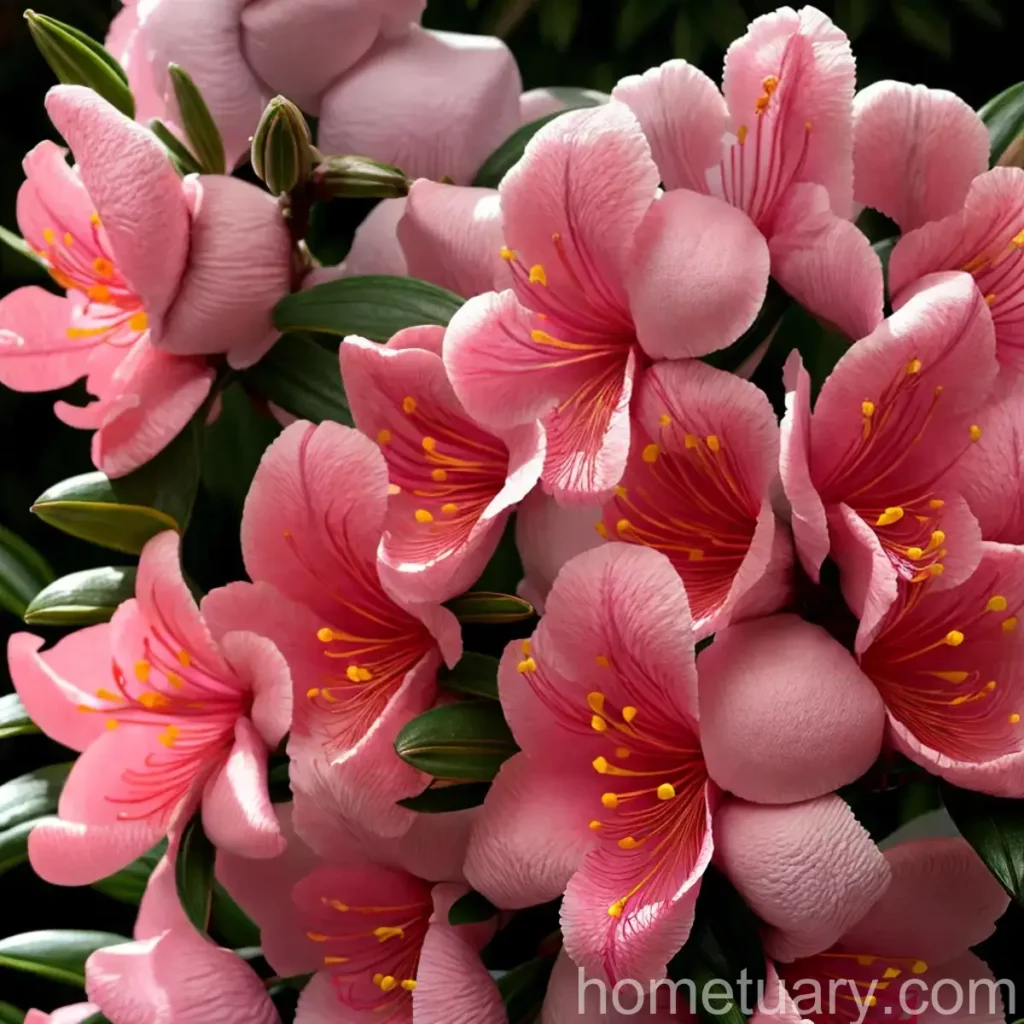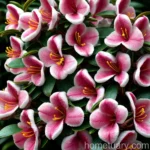Plant Scientist’s Guide to Azalea (Rhododendron ‘Jolie Madame’)
Introduction
Azaleas are beloved flowering plants that belong to the Rhododendron genus. They are known for their vibrant and abundant blooms, making them popular choices for gardens, landscaping, and indoor decoration. Among the numerous varieties of azaleas, the Rhododendron ‘Jolie Madame’, also known simply as azalea (Jolie Madame), stands out for its stunning flowers and exceptional growth characteristics.
In this comprehensive guide, we will delve into the world of azaleas, with a specific focus on the Rhododendron ‘Jolie Madame’ variety. We will explore its cultural requirements, uses, care tips, and common challenges that gardeners may encounter when cultivating this captivating plant.
What is Azalea (Rhododendron ‘Jolie Madame’)?
Azalea (Rhododendron ‘Jolie Madame’) is a beautiful flowering shrub that is highly valued for its exquisite blossoms, which come in a range of colors, including shades of pink, purple, red, and white. The ‘Jolie Madame’ variety is particularly esteemed for its compact growth habit, making it an ideal choice for container gardening and smaller landscapes.
This evergreen shrub typically reaches a height of 3 to 4 feet and a spread of 3 to 4 feet, providing a lush and colorful display during the blooming season. The leaves of the Rhododendron ‘Jolie Madame’ are dark green and glossy, adding to the plant’s ornamental appeal even when not in bloom.
Key Takeaways – Azalea (Rhododendron ‘Jolie Madame’)
Before we delve into the specific aspects of caring for the Rhododendron ‘Jolie Madame’, let’s summarize the key takeaways related to this captivating azalea variety:
Culture
- Compact growth habit, ideal for container gardening and smaller landscapes.
- Spectacular and varied blooms, ranging from pink and purple to red and white.
- Dark green, glossy leaves add to its ornamental appeal.
Uses
- Suitable for gardens, landscapes, and indoor decoration.
- Adds vibrant and colorful displays during the blooming season.
Water
- Consistent and adequate moisture is essential, especially during the growing season.
Sunlight
- Prefers partial shade to full sun, with protection from the hot afternoon sun.
Fertilizer
- Benefits from a balanced slow-release fertilizer, applied in early spring.
Soil
- Requires well-draining, slightly acidic soil for optimal growth and bloom.
Pruning
- Regular pruning after flowering helps maintain a compact shape and promotes future blooms.
Propagation
- Can be propagated through cuttings, layering, and seeds for expanding your azalea collection.
Container Popularity
- Well-suited for container gardening, offering versatility in placement and display.
Common Diseases
- Susceptible to certain fungal diseases, requiring attention to prevention and management.
Disease Diagnosis
- Vigilance is necessary to identify and address any signs of fungal infections promptly.
Common Pests
- Vulnerable to azalea lace bugs, spider mites, and other common garden pests.
Azalea (Rhododendron ‘Jolie Madame’) Care Guide
Caring for Rhododendron ‘Jolie Madame’ involves understanding and addressing its specific requirements for water, sunlight, soil, and maintenance. By providing the optimal conditions, you can ensure that your azaleas thrive and produce magnificent blooms year after year.
Water
Azaleas, including the Rhododendron ‘Jolie Madame’, require consistent moisture to support healthy growth and prolific flowering. Proper watering practices are crucial in ensuring the well-being of these charming shrubs. Here are some essential points to consider regarding the water needs of azaleas:
Azalea Watering Requirements
- Frequency: During the growing season, water deeply and regularly to maintain consistent moisture levels. This is particularly important during periods of drought or dry weather.
- Avoid Waterlogging: While azaleas require ample moisture, it’s important to prevent waterlogging, which can lead to root rot and other issues. Ensure that the soil has good drainage to prevent water accumulation.
- Mulching: Applying a layer of organic mulch around the base of the plants helps retain soil moisture and regulates soil temperature. Mulching also minimizes weed competition, benefiting the overall health of the azaleas.
Sunlight
Proper sunlight exposure is crucial for the overall health, vigor, and blooming capacity of azaleas. Understanding the sunlight needs of Rhododendron ‘Jolie Madame’ is essential for optimizing its growth and flowering potential.
Rhododendron ‘Jolie Madame’ Sunlight Needs
- Ideal Conditions: Azaleas thrive in partial shade to full sun, with some protection from the intense afternoon sun. Positioning them in locations with dappled sunlight or morning sun and afternoon shade is beneficial.
- Sunscald Prevention: In regions with hot climates, it’s important to shield the plants from excessive sun exposure, which can cause sunscald and leaf damage. Utilize natural shade or protective coverings during peak sunlight hours to safeguard the azaleas.
- Indoor Placement: If grown indoors, ensure that the azaleas receive abundant indirect sunlight to support healthy growth and flowering.
Fertilizer
The application of fertilizer plays a pivotal role in nourishing azaleas and supporting their vigor, bloom production, and overall health. Understanding the appropriate fertilization methods for Rhododendron ‘Jolie Madame’ is essential for promoting robust growth and abundant flowering.
Azalea Fertilization Methods
- Balanced Fertilizer: Utilize a slow-release, balanced fertilizer specifically formulated for acid-loving plants. Apply the fertilizer in early spring, following the package instructions for the proper dosage and application method.
- Organic Amendments: Incorporating organic matter, such as compost or well-rotted manure, into the soil around the base of the plants contributes to long-term soil fertility and provides essential nutrients to the azaleas.
- Avoid Overfeeding: While azaleas benefit from periodic fertilization, it’s important to avoid excessive feeding, which can result in adverse effects on plant health and blooming potential. Adhere to the recommended feeding schedule and dosage to prevent fertilizer-related issues.
Soil
Azaleas, including the Rhododendron ‘Jolie Madame’, have specific soil requirements to support their growth, root development, and flowering. Optimal soil conditions are fundamental in ensuring the well-being and vitality of these stunning shrubs.
Best Soil for Growing Azaleas
- Acidic pH: Azaleas thrive in slightly acidic soil with a pH range of 5.5 to 6.0. Conduct a soil test to determine the pH of the planting site, and amend the soil as needed to achieve the ideal acidity level for azaleas.
- Well-Draining: Good drainage is essential to prevent waterlogging and root rot. Amending the soil with organic matter, such as peat moss or compost, improves soil structure and enhances drainage.
- Soil Structure: Azaleas prefer a well-aerated and loose soil texture that supports healthy root growth. Avoid compacted or heavy soils, and consider incorporating perlite or vermiculite to improve soil structure.
Pruning
Pruning is a valuable aspect of azalea care, enabling gardeners to shape the plants, promote bushy growth, and encourage abundant flowering. Understanding the appropriate pruning techniques for Rhododendron ‘Jolie Madame’ is essential for maintaining its aesthetic appeal and health.
Azalea Pruning Techniques
- Post-Flowering Pruning: After the blooming period, perform light pruning to remove spent flowers and maintain the desired shape of the plants. Avoid extensive pruning immediately after flowering, as this can reduce the following year’s bloom potential.
- Branch Thinning: Regularly thin out overcrowded and crossing branches to improve air circulation and light penetration within the canopy, reducing the risk of disease and promoting overall plant vitality.
- Renewal Pruning: Periodically engage in rejuvenation pruning to remove older, woody branches and stimulate new growth. This helps rejuvenate older plants and promotes robust flowering in subsequent seasons.
Propagation
Expanding your collection of Rhododendron ‘Jolie Madame’ and propagating new azalea plants can be an exciting endeavor. Understanding the propagation techniques suitable for this variety allows you to create additional plants for your garden or share them with fellow gardening enthusiasts.
Tips for Propagating Azaleas
- Softwood Cuttings: Propagate azaleas through softwood cuttings taken in early summer. Select healthy, non-flowering shoots and root them in a suitable rooting medium to establish new plants.
- Layering: Air layering is another effective method for propagating azaleas, allowing you to induce rooting on a branch while it is still attached to the parent plant. Once the new roots develop, the rooted branch can be separated and transplanted.
- Seeds: While more time-consuming, growing azaleas from seeds is a viable propagation method. Collect mature seeds from the plant, sow them in a suitable growing medium, and provide the necessary warmth and moisture for germination.
Container Popularity
Rhododendron ‘Jolie Madame’ is well-suited for container gardening, offering versatility in placement and display. Growing this stunning azalea variety in containers allows you to showcase its vibrant blooms and glossy foliage in various outdoor and indoor settings.
Common Diseases
Azaleas, including the Rhododendron ‘Jolie Madame’ variety, are susceptible to certain fungal diseases that can impact their health and blooming capacity. Understanding the common diseases and implementing preventative measures is essential for maintaining the vitality of these beloved plants.
Disease Diagnosis
- Leaf Spot: Keep an eye out for signs of leaf spot, which presents as dark or discolored spots on the foliage. Adequate air circulation and soil moisture management can help prevent this fungal issue.
- Powdery Mildew: A white, powdery coating on the leaves indicates the presence of powdery mildew. Ensure proper spacing between plants, and avoid overhead watering to minimize the risk of this fungal disease.
- Root Rot: Excessive soil moisture and poor drainage contribute to root rot, leading to wilted foliage and overall decline. Promptly address drainage issues and adjust watering practices to prevent this potentially fatal disease.
Common Pests
Azaleas are also vulnerable to attack by common garden pests, including azalea lace bugs, spider mites, and aphids. Monitoring for signs of pest infestation and implementing effective pest control measures is essential in safeguarding the health and beauty of Rhododendron ‘Jolie Madame’.
Botanist’s Tips
- Companion Planting: Pair Rhododendron ‘Jolie Madame’ with other acid-loving plants, such as heathers, camellias, and ferns, to create harmonious and visually appealing planting combinations.
- Winter Protection: In regions with harsh winters, provide insulation and protection for azaleas to shield them from cold temperatures and frost damage. Mulching around the base of the plants helps maintain stable soil temperatures and protects the roots.
- Wildlife Attraction: Azaleas, including the Rhododendron ‘Jolie Madame’, are known to attract pollinators such as bees and butterflies, enhancing the biodiversity and ecological value of the garden.
- Optimal Blooming: Prune azaleas after flowering to encourage new growth and bud formation for the following year. This promotes vibrant blooms and ensures a stunning display during the blooming season.
Fun Facts
- The name azalea is derived from the Greek word azaleos, which means “dry” or “arid.” This name reflects the plant’s preference for well-drained soil conditions.
- Azaleas are associated with various meanings and symbolism, including abundance, beauty, and expressing feelings through the language of flowers.
Links to External Resources
For additional information on the care and cultivation of Rhododendron ‘Jolie Madame’ and azaleas in general, consider exploring the following resources:
- American Rhododendron Society
- Royal Horticultural Society – Azaleas and Rhododendrons
- University of Florida IFAS Extension – Azalea Growing Problems
In conclusion, the Rhododendron ‘Jolie Madame’, also known as azalea (Jolie Madame), is a breathtaking and versatile plant that enriches gardens, landscapes, and indoor spaces with its vibrant blooms and ornamental foliage. By understanding and attending to its specific cultural requirements, such as water, sunlight, soil, and maintenance, you can ensure the continued health and beauty of this beloved azalea variety.
Whether you’re a seasoned gardener or a novice enthusiast, cultivating azaleas offers a rewarding and enchanting experience, enriching your outdoor spaces with the allure of its captivating flowers and lush greenery. With the tips and insights shared in this comprehensive guide, you’re well-equipped to embark on a journey of nurturing and enjoying the splendor of the Rhododendron ‘Jolie Madame’ in your own garden.
Remember, the beauty of azaleas lies not only in their breathtaking blooms but also in the joy and tranquility they bring to the hearts of those who admire them.
So, go ahead, embrace the allure of azaleas, and create a vibrant tapestry of color and elegance with the enchanting Rhododendron ‘Jolie Madame’.
Happy gardening!















